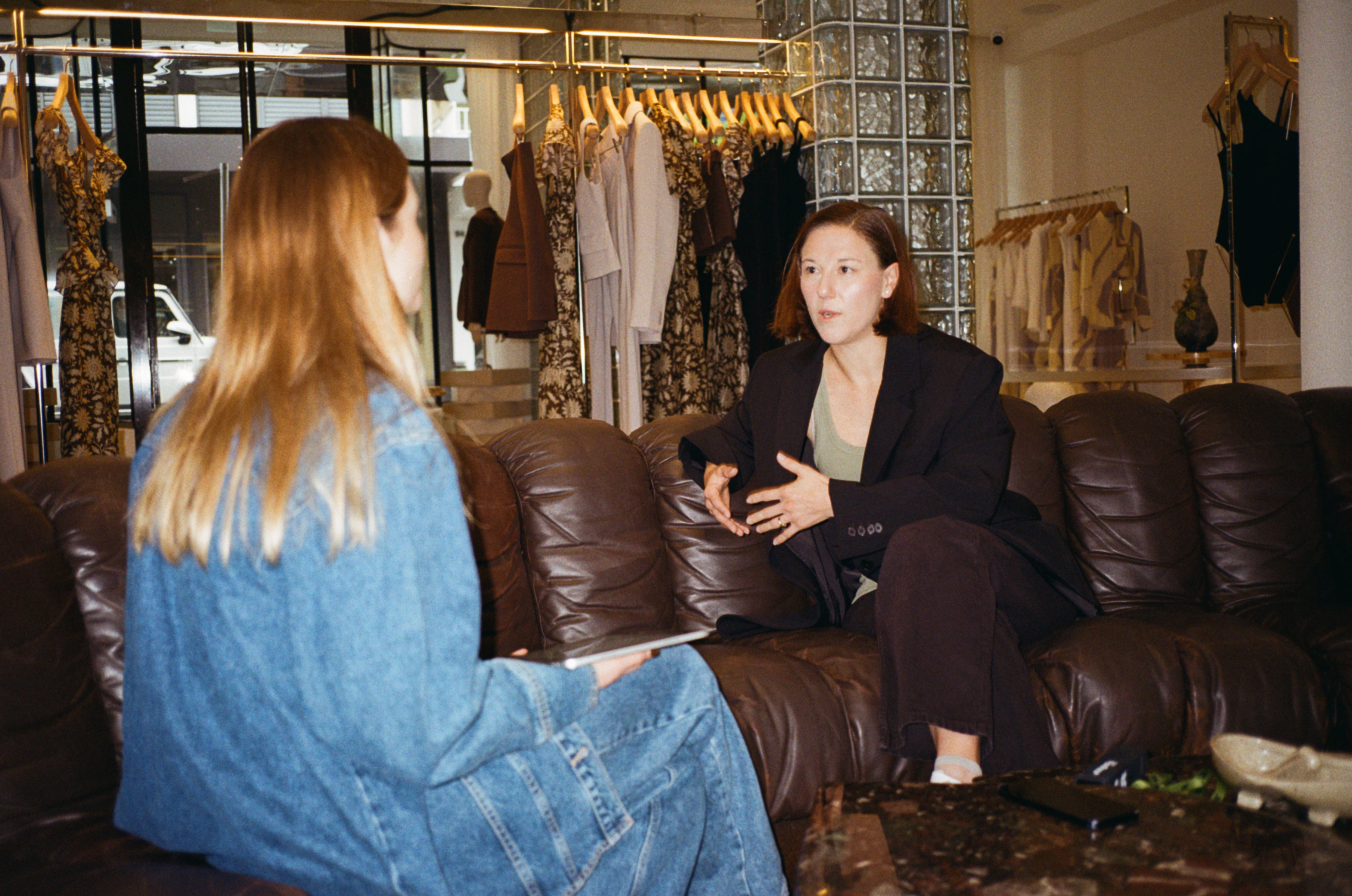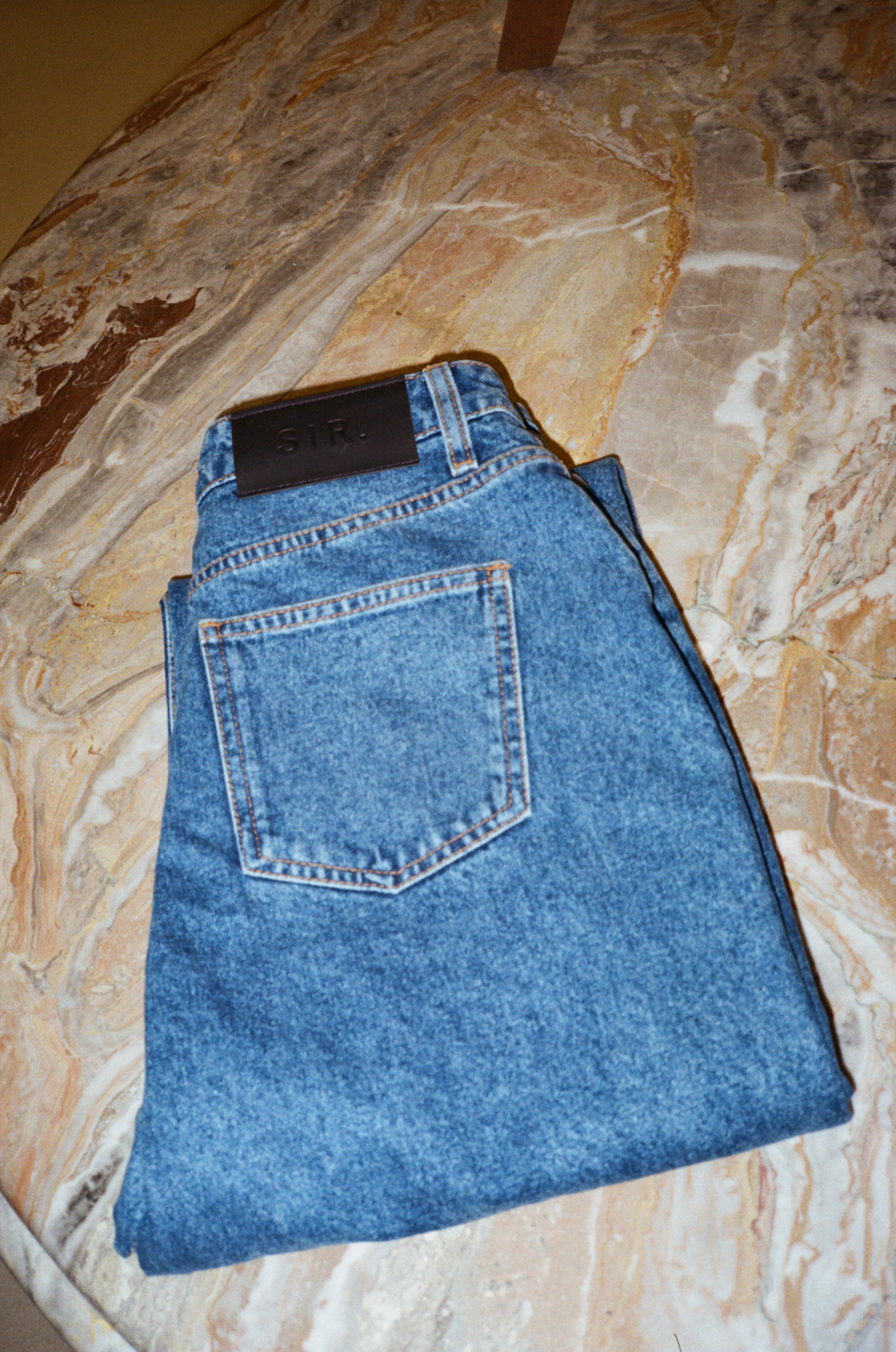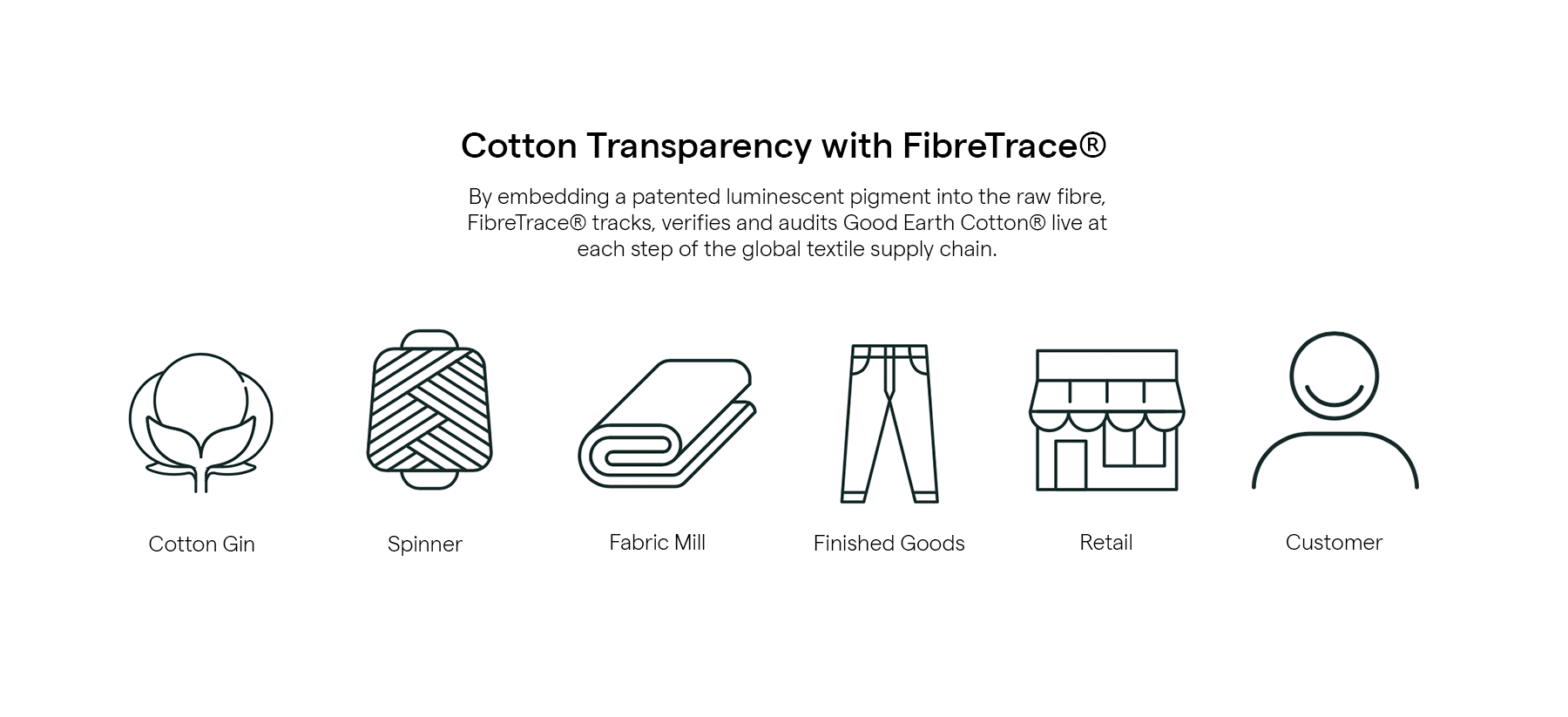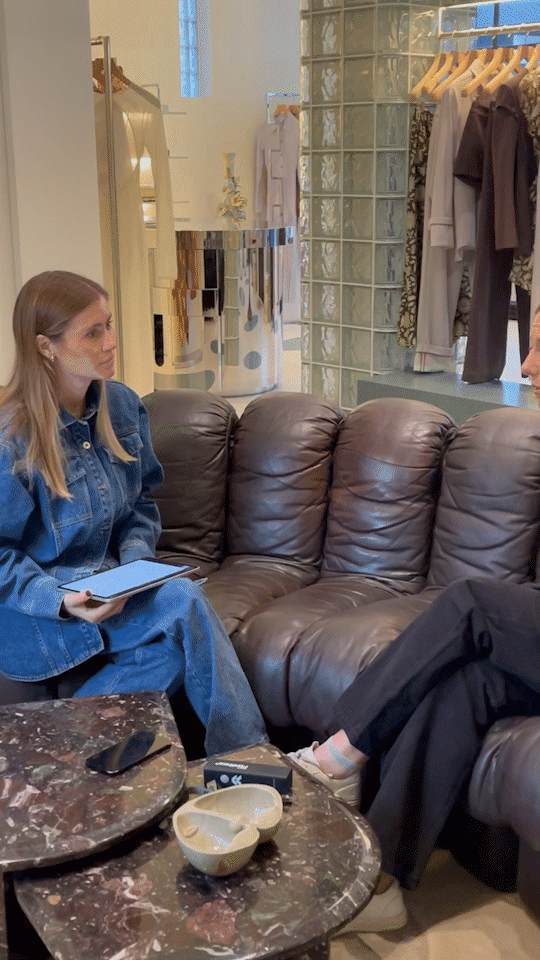YES SIR | In conversation with Kara Hurry & Sophie Coote

In conversation
With Kara Hurry & Sophie Coote.
The future of fashion is transparent. FibreTrace® is paving the way for brands to gain transparency over supply chains with mapping from seed to store through FibreTrace® MAPPED.
FibreTrace® MAPPED is the key to a transparent future and in turn future-proofing the industry.
SIR. has worked with FibreTrace® since 2021. We are proud to be early adopters of the technology, one of the first brands to experience the advance through the FibreTrace® MAPPED pilot program – allowing us to to map the journey of our Good Earth Cotton® denim and tanks from seed to store.
As we continue to evolve our partnership with FibreTrace® we have ambitions to utilise the technology across a broader range of fabric bases – furthering our mission of bringing true transparency and traceability to SIR.


Here, SIR. Co-founder and Creative Director, Sophie Coote and FibreTrace®’s Chief Marketing Officer, Kara Hurry, discuss the importance of traceability in fashion and common hurdles faced in the industry.
SOPHIE COOTE
First of all, thank you for joining us for our YES SIR. In Conversation. Could you tell us a little about yourself and how you came to be a part of FibreTrace®.
KARA HURRY
Thank you for having me, always a pleasure.
A little bit about myself, essentially, I've worked in the fashion industry for a long time now. I've been really lucky to work from farm through to manufacture through to brands. So, I had years where I was the lead for the Northern Hemisphere for the Woolmark Company working on behalf of Australian wool growers, taking their fibre into new products and development arenas and marketing partnerships, through to working with brands like Louis Vuitton.
I'm really thankful to have had that experience across the industry sector and that's what really drew me to FibreTrace®. When I was lucky enough to meet Dani and Shannon and the team, and heard about the technology and its plausibility, for good American saying, I drank the Kool Aid – I could see the potential to really change our industry, for the better.
SC: Incredible, super cool. It definitely had such a huge impact on us when we first heard about it as well. Through all of our traceability issues in the beginning, with producing offshore, you know, trusting manufacturers, and there's so many false products out there. It’s a real minefield, so hearing about Dani and Shannon has been so incredible.
KH: That's good. It's great to know we're making a difference.
SC: FibreTrace® MAPPED officially launched earlier this year. How long has this been in development?
KH: We're always in development – that’s a good way to answer that.
FibreTrace® has always had a physical and digital technology component, which is what's really set us apart.
In the first year of coming to market, we had so much feedback from our brand partners, such as yourself, that said – hey, your digital component needs to offer more, it needs to be more flexible, and it needs to be able to work without the digital implications if we want it to. So really, the development was probably at least a 12 month pathway. But we had a nine month pilot pathway where we had 61 brands. Thankfully SIR. were included in that, farmers and manufacturers participate, which allowed us to really test and modify the platform to be ready for launch.
I guess, nine months would be a short answer.
SC: Wow, that’s actually not that long in terms of actual tech development. That’s incredible.
KH: Yeah, it is, considering it took us three years to get the full physical and digital tech to market. Digital's obviously a little more rapid. Since we launched MAPPED, only in January, we've had about 500 new partners come on board.
SC: Wow, that's huge – and so that’s everywhere?
KH: Everywhere, that's at a global level and includes brands to manufacturers – but what that's allowed us to do is watch how everybody's using the platform and see where the pain points are. Now as a team, we're already shaping up what we're calling a gamma pilot – the next phase with some large enterprise scale supply chains to learn more.
For example, with the changes that have been announced in legislation – what can we do to update and automate the reporting to make it easier for the industry who uses it.
SC: Oh, that’s amazing. You know, for us that’s been a huge challenge in terms of how resource heavy it has been on some of these projects and engaging on them. So that’s huge.
KH: Yes, and I think it’s always going to be – that is so it. We were talking internally the other day about making a matrix, from administration on one end through to compliance or risk mitigation on the other end.
Some people, if you're working for a multinational kind of corporation, of course, you've got more staff, more resources, more cash, more auditing, so you've got more data – therefore, you're probably at this top end, where you're going to have massive administration burden, because you've got so much data certification audits, everything else going on.
Whereas at the other end – if you're a brand, just starting out on your journey, you're a year into business, of course, you don't have all that framework. You just want to know, what's the minimum I can do to do good, and to grow.
It's just a journey, transparency tech is still new whether it's us or anyone else. It’s good.

SC: Where did the concept of FibreTrace® MAPPED stem from? It’s amazing.
KH: It stemmed from feedback from the industry first and foremost, but the second place it stemmed from was our want to remove some of the cost barriers involved.
One of the facts that I love is circularity became a formal term in 2009, we're now sitting here in 2023 and the industry still doesn't have the issue solved.
So, compliance, whether we like it or not lately with the UFLPA in the USA, and the digital product passport in Europe is forcing that change now, which is good to see. It gives us a bigger reason for change. I think that MAPPED itself, the concept of it was, we hear the industry saying we want traceability, but what are our pain points? One of those pain points we just talked about as admin.
SC: Definitely.
KH: The second pain point is price. So we were like, okay, can we change this so that for smaller companies, it's always free? Then there's minimal cost spread across the supply chain, to get involved in taking the journey together.
SC: Has there been any sort of government support on any of these projects?
KH: From a FibreTrace® perspective, no. We were really lucky to have a pool of solid, private investors. They really believe in us and have allowed us to continue to forge that pathway. I think that maybe the time will come soon.
SC: If you're enforcing it on one side, surely there should be support on the other – maybe that will be something that happens down the track.
KH: I also think with the transparency tech industry, more and more competitors are entering this space, right? Because it's growing, which is exciting. I think actually, though, it's a good thing. Because in a way it will force some kind of cohesion between the competitors to be able to answer the general industry challenges, and I think this is probably when government or peak industry bodies will start to get more involved too.
SC: For sure, that makes sense.
What do you think some of the most common misconceptions are around true traceability?
KH: Oh, that's a big one. I think one of the biggest challenges with traceability is there's a common misconception that digital blockchain is a solution. Digital blockchain is a tool, it is not a solution. Essentially, it's digitising the current paper trail, but those of us, like you and I, who have been in the industry a while, have quite eyes open on the fact that unfortunately, there's a lot of fraudulent information in those paper trails. Sometimes it's also not in a negative context, like sometimes it's a small factory who doesn't have the time or it's a human error.
SC: From our experience, we had fake certificates being provided and we assumed people were doing the right thing. We're paying premium prices for fabric that was said to be sustainable, organic – all of those words that are just used. I guess we had to learn, not too much the hard way, but I guess, that was out there and not really ideal in regards to what we stood for as a business. When we first heard about FibreTrace® it was so legitimate and exciting, and obviously being able to go to the farm, which we did, was just such a great trip – actually seeing that from start to finish, knowing that it was the truth.
KH: Yeah! It’s becoming more and more common within the industry, which is really awesome. I think that it's people having that understanding and having the opportunity to learn that. Digital traceability and blockchain is a support tool to get the information in and to understand what's happening and where in your supply chain, it should then inform you to look deeper. You know, it is not the ultimate solution, It's not a silver bullet.
I think the other misconception that I struggle with in all the conversations I have with brands and manufacturers and even farmers, is people seem to think that the government now that regulatory compliance is coming in, will set an exact pathway for the textile and apparel industry, but it won't, it's just not plausible. I don't think it is anyway.
You think about it in the context, of something like finance, so you think okay, yes, there are absolutely financial regulations for corporations and companies, not an industry specific level most of the time. So therefore, even in Australia, we've got the big retailers, they would have different financial standards, systems, processes that they think are right by their company, but they abide by the law and regulation.
Whereas when I speak to sustainability teams, there's often this wish that you know what, the industry is just going to have one set of compliance that we all follow. If you look at any other department within the company, I don't think that’s plausible and I don't think it's realistic.
We need to, I guess be a bit more proactive and a bit more forward, rather than waiting for the answers to come. We need to be ready to speak up to share those answers.
SC: So, in your experience, what is needed for the industry to foster true verification? And how does FibreTrace® make that a reality?
KH: Ah, true verification really does come, I know I'm going to sound very biassed here coming from FibreTrace’s® point of view, but it really can only come when you have digital and physical technology combined. So whether it's FibreTrace® or another solution, you need to have some kind of physical verification on that fibre to ensure it is that fibre in your hands at the end of the day.
SC: Absolutely, makes a lot of sense.
KH: I think that is true custody of supply and second to that would be real time notification throughout your production cycle around the world.
SC: What other shifts do you hope to see in the industry?
KH: That’s another big one.
SC: You’re thinking, where do I start! [both laugh]
KH: The biggest shift in the industry, it sounds cliche, but it's more collaboration. It's more talking like we're doing now. It's being willing to share information and not holding it back. The fashion industry is a really hard industry to compete in.
SC: It is – people hold their cards close to their chest and aren't necessarily collaborative. Although I am seeing so many changes in that. We've spoken to the teams at Reformation and GANNI about different pieces and they're so willing to share on the level of sustainability to help people do better for the planet. We've found people being freely open and really willing to have conversations with us and sort of pointing us in the right direction and asking them what barriers they've been up against. I think it's that new age of fashion, seeming to be stamping out that older mindset in that sort of thing.
KH: Agree. I think it's just more and more of that.
Even to the point, like we were saying before with the technology, the transparency tech players – there's some of us that are all starting to share information too. We need to – I had a really good conversation actually with Everledger and TrustTrace who are our competitors, but instead, we were able to share enough that talks about where we think we need to focus to add better value to the industry by simply accelerating forward. I think there will probably be more and more of these kinds of alliances and sharing and collabs, which is a really good thing.
The other thing I would say is reality. The biggest challenge the industry is going to face – you touched on it before with fraudulent certification, or fraudulent claims. With all the best intentions, everyone in the industry only has the best intentions. I never judge on that but I think at times, there are organisations that know that they are driving on price, and therefore naturally, they can't garner some of those qualities and claims or green or climate status that they want.
SC: And particularly those big corporations, I guess that's why these regulations are coming into play because people are identifying them. It's happening, and it’s fraudulent claims.
KH: Yes. I think it's having that appreciation and ability to not judge, right. Because when we walk into somewhere, that is a very different culture, you know, it's really easy for us to sit in Australia or sit in Europe or sit in USA and pass judgement on other regions. And it's like, oh, they shouldn't be doing that, and it's like, well, we don't live there, we didn’t grow up there, we don't know what it is like. It's a very different culture. It's a very different education structure. It's a very different system. So I think it's just having that ability to be real without judgement and go, yeah, that is a problem for them. Rather than just throw our hands up and say that's bad and walk away. How do we modify the way we're working to support that change?
SC: Amazing, that’s awesome. So let’s chat a little bit about the next steps for SIR. and FibreTrace®. Obviously we’ve previously discussed moving your technology, so could you tell me a little bit about your progress there and like where you are at in that expansion?
KH: Very exciting. Cotton, obviously, as you know, was our first and foremost but we are really excited we've released commercially to market on both recycled polyester, responsible acrylics and other responsible synthetic fibres, so that's now well in market.
We are about to release commercially on Australian Merino Wool and other wool projects, which is really great. You'll actually see some suppliers with samples in the market literally within the next season.
SC: That is super exciting – is that relationship in terms of sourcing etc, we've had these conversations before, but Woolmark will be covering some of that?
KH: Woolmark has been involved in our pilot programs, we are really thankful for their support but, when it gets to commercial level, it's really the manufacturers who get involved directly with the farmers.
On a local level, we've been working with an amazing wool player, I guess you could call them a merchant or an auctioneer called Fox and Lilly. They've been really progressive and forward thinking and helpful for us in sharing what we need to learn about the wool industry and applied differently. To make this work for the market. So yeah, so we're excited by that one.
We've had linen under research and development for about 12 months now in France.
SC: Amazing, linen is huge for us obviously with our focus on natural fabrications.
KH: Yes, yes! We have hit some hurdles, because linen processing from its raw stage is much more intensive. So it's fine. It's all part of the r&d process, we've just got to work out how to change our pigment for application. We think we now have an answer and we're doing those final trials within the next three months. If that works, we'll then be going to commercial scale and hopefully you'll see linen on the market early next year. We've only just started on leather.
SC: Wow. So what countries are you looking at with those processes?
KH: Wool has very much been centralised in Asia. So Thailand, Vietnam, China has been our mainstay, because that's where a lot of the scouring happens. For linen, it's very much been France based, because France is one of the key raw producers of flax.
SC: I've heard India as well, but is that a bigger midfield to start in?
KH: The guys we are working with actually produced 63% of Europe's linen or flax and there’s an association there that rolls out training for the rest of the industry. So for us, it was important to start there, and we'll obviously be able to transfer the learnings from there.
SC: Okay, amazing!
KH: So Soph, what are the big challenges you see? If you think about traceability and what you've learned through the FibreTrace® journey. What do you think needs to be eased, or changed, or what new technology do we need to add?
SC: Look, I think moving across fabrications for us is a big one. It's exactly the conversation we were having before. Resource challenges, but I think FibreTrace® have done a really good job of it. The whole process of these particular garments that we've worked with from start to finish has been really easy.
So yeah, I guess for us, it's more so the movement into those new fibres and how that would work, the lifecycle of that and how we integrate it.
KH: Listening to you say that, it’s also setting up manufacturing meet and greet networks.
SC: That would be amazing. I think that is also the challenge. For us as a company, our key takeaways from all of the different conversations we've been having, even on the carbon side of things, and making sure that we're actually making changes from the stem of the issue, rather than reacting or solving the problem by throwing cash at a situation to offset – that's the direction we are interested in going on a holistic level. With our suppliers as well, making sure that we're aligned, I think there's so many people wanting to do the right thing.
We've been having conversations with VertScience as well. I love the work that they're doing, but for us as well, from a resource perspective, we're so lean. We're looking at the next five years and thinking okay, realistically, what do we want to do that's going to make the biggest impact.
For example, if you [FibreTrace®] had a supplier who was going to move in the wool space that was great, starting with them now so once it's ready to go, we’re set up and ready to integrate. Then choosing the source root farms and suppliers that align with us. That for us will make the biggest impact when we are ready in a few years, putting more resources into it.
KH:
Awesome. No, that absolutely makes sense.
SC: Doing the right groundwork. That has been another challenge – listening to all this different information that's out there, digesting that, and then really thinking about what’s going to make the biggest impact?
KH: Yeah, no I love that. It actually puts me in a thought process of how we can start to build those opportunities for everyone.
SC: Especially you, you're such a connector of all things. You really opened us up to this opportunity, so thank you. We’re excited to continue the journey!
KH: Anytime! Us too.























